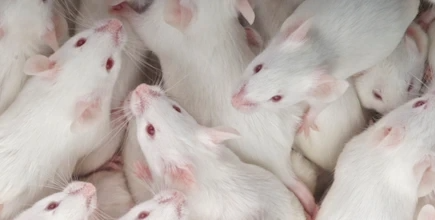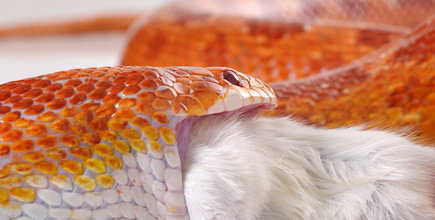
Snakes and many other reptiles are what are known as obligate carnivores, being limited in their diet to consuming other animals. In the wild, this normally means that they are predators, hunting and subduing their own prey although it is not uncommon for them to scavenge when the opportunity presents itself. Many snakes and lizards have been observed feeding upon carrion, and this behavior is probably even more widespread than known. They have a variety of means of subduing prey ranging from those who simply seize and swallow their food alive or overcome it by biting or mauling to those utilizing some form of constriction and finally the venomous snakes with their highly developed systems of fangs and venom.
Pros and Cons of Feeding Live Prey to Snakes
Although reptiles are equipped to successfully obtain their meals from the wild, it is a mistake to equate this ability with the need to feed upon live prey in captivity. Most captive reptiles are willing to accept frozen/thawed food under captive conditions, and this practice is beneficial for a variety of reasons.
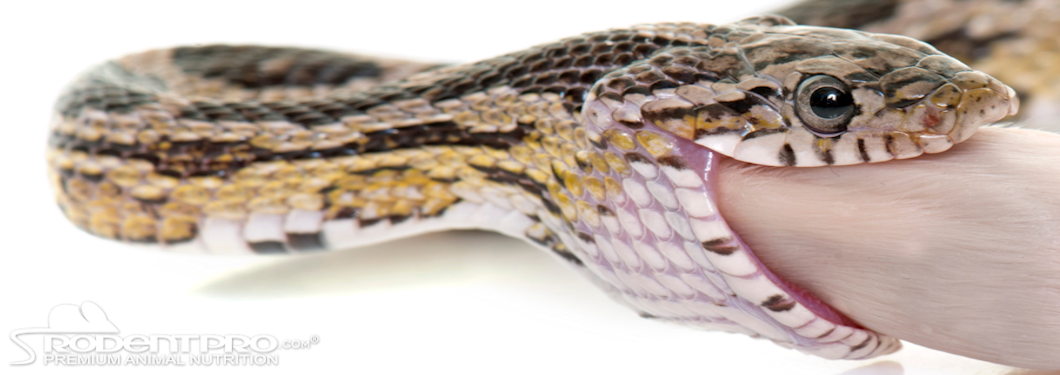
When it comes to live vs. frozen snake food, first and foremost, as an argument for the feeding of frozen/thawed food, is the danger posed to the captive animal by the live prey animal. Live prey, such as rodents, are quite willing to defend themselves against predation. It is not unusual to find wild specimens of reptiles that exhibit evidence of defensive wounds suffered during attempts to overcome prey. Some of the scars and wounds left behind are truly impressive, and it must be considered that these are only the individuals who have survived the experience.
Defensive wounds to captive animals inflicted by intended live prey are frequently seen by veterinarians and often require expensive and prolonged care. It should also be noted that should the intended meal not be devoured immediately and left in the reptile’s enclosure, the specimen may well suffer an attack from the uneaten meal. Reptiles seldom seem willing or able to defend themselves from these attacks and horrific injuries or death is often the result.
It is also true that many captive reptiles are reluctant to feed upon live prey items. In a confined space, the sudden movements of the potential meal may so startle or alarm the captive that it loses the desire to feed. This is frequently observed in snakes, which are often reluctant to feed unless they are relaxed and do not feel threatened or defensive. Generally speaking, it is much more likely that your specimen will be willing to accept food if they are unexcited by other stimuli. Frozen/thawed food is often attractive to an animal that otherwise may be discouraged from eating by the activity of a live prey item, such as a chicken or rabbit.
Yet another point to consider is the pain and fear suffered by live prey animals. Although it is certainly true that the maintenance of reptiles in captivity requires that they are fed appropriate meals, it is also the case that there is a responsibility that the food animals involved be spared unnecessary pain and suffering, which is often not the case when a reptile makes its own kill. By offering frozen/thawed food items that were humanely euthanized, we can avoid exposing the feeder animal to unnecessary pain and suffering.
Pros and Cons of Feeding Frozen Rodents to Reptiles
Feeding reptiles frozen/thawed rodents, such as mice, rats, hamsters, or gerbils, offers numerous benefits.
Snakes and lizards that normally consume live prey usually exhibit no reluctance to feed upon frozen/thawed food. Sometimes, it may be necessary to utilize feeding tongs or tweezers to gently move the item about to attract the animal’s attention to the food, but most specimens will quickly learn to locate their food by scent alone.
As a side note, never offer food with your bare hands, as feeding response strikes are frequently off-target enough to seize your hand instead of the food. Using a feeding tool to place the food item at the entrance of the reptile's hide box will frequently encourage a feeding response as an animal that is in its hide usually feels more secure. If you have multiple animals sharing the same enclosure, it is always a good idea to separate them prior to feeding to prevent accidents, such as two animals seizing the same food item.
There is also no comparison to the ease of feeding frozen rodents vs live to reptiles. For instance, our frozen rat feeders offers high-quality nutrition for your reptile pets. Frozen rodents for reptiles are available in sizes ranging from pinkies to extra-large adults to suit the needs of your particular animal.
Whether your reptile prefers a white feeder mouse, a dark feeder mouse or a hairless feeder mouse, you can fulfill their best dietary needs at RodentPro.com.
Tips for Safely Handling and Preparing Both Live vs. Frozen Snake Food
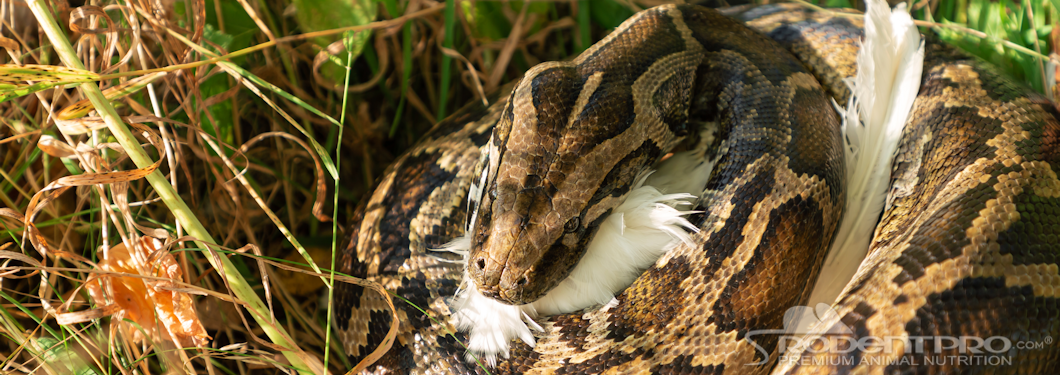
Preparing Live Mice for Feeding
Before feeding live mice, inspect the animal to ensure it appears healthy and is the appropriate size for your snake. Keep in mind that live mice are more likely to harbor disease than the frozen variety. Again, feeding live mice to snakes is not a recommended practice.
Proper Storage Practices
The storage of food supplies also presents a situation that greatly favors the use of frozen/thawed items. Live feeder rodents require a large amount of space and expense for their maintenance. In addition, they need a large investment in time for their proper care. Failure to provide these resources is both inhumane and will result in serious environmental and health issues such as odors and increased risks of disease. In contrast, frozen-thawed food items can be easily stored in a freezer and removed as needed. The odor and disease issues are reduced to insignificant levels with proper care, and a large supply of food can be maintained with minimum effort.
Frozen animal food should be stored separately from where human food is stored, prepared or consumed. Frozen reptile food can be kept in the freezer and taken out for feeding as needed. As long as it is kept frozen and well packaged to avoid exposure to air, it will remain fresh for a prolonged period of time.
It is not uncommon to experience difficulty locating exact sizes and quantities of frozen prey items at a local pet store. Alternatively, these items can be easily obtained by ordering from our website, www.rodentpro.com, and can be ordered in bulk quantity at substantial cost savings.
Live Feeders for Captive Reptiles
RodentPro.com offers a wide selection of live reptile food for your convenience. The nutritious insects and worms available for your reptiles include:
- Crickets
- Mealworms
- Giant mealworms
- Superworms
- Waxworms
- Hornworms
- Nightcrawlers
- Red wigglers
- Fruit flies
These live worms and insects are also ideal food for amphibians, arachnids, wild birds and fish.
Thawing Frozen Reptile Food
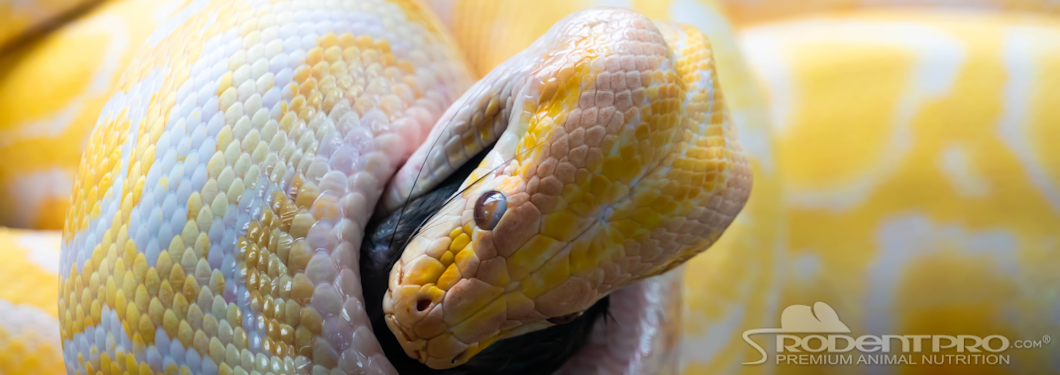
The proper thawing process is essential for maintaining the quality of the product. The safest and most effective method for thawing frozen animal food is to do so in a refrigerator set to 40°F. Avoid thawing frozen food using excessive heat sources like a microwave or hot water. After thawing, place the food in a sealed bag and submerge it in warm water to reach the desired temperature. Do not use the kitchen sink or food preparation areas for thawing. If any food remains uneaten, it should be discarded rather than refrozen or given to other animals, as this could spread disease.
Safe Handling Best Practices
Always place frozen food in the freezer as soon as you receive it. When handling frozen animal food, use personal protective equipment, such as latex gloves and a mask. Always wash your hands immediately afterward. After drying your hands, consider following up with an alcohol-based hand sanitizer to maximize hygiene. After each use, clean and disinfect all surfaces and equipment. Never eat or drink while handling animal food. The same holds true for smoking.
Higher risk individuals should not handle frozen animal food, these include:
- Children 5 years old and under
- Pregnant women
- Those with compromised immune systems
Conclusion
In summary, feeding frozen/thawed food items is highly recommended for captive reptiles. Feeding live rodents is not recommended. By opting for frozen/thawed food rather than live rodents, you avoid many potentially serious problems and inconveniences and have gone a long way toward ensuring that your animal enjoys a lengthy and trouble-free life.
RodentPro.com offers a complete selection of frozen feeders for high-quality nutrition, including frozen mice, frozen rats, frozen rabbits, frozen guinea pigs, frozen hamsters, frozen gerbils, frozen chickens and frozen quail.
RodentPro.com also offers a 100% customer satisfaction guarantee. We guarantee frozen delivery on all products and exact sizing specifications. We also guarantee the quality, appearance and freshness of every product we ship.
Since its founding more than 30 years ago, RodentPro.com has specialized in producing and distributing premium-quality animal foods, including frozen foods, live foods and other foods and supplies. We are proud to include hobbyists, commercial reptile breeding facilities, raptor sanctuaries, wildlife rehabilitators, animal rescue centers and some of the nation's largest and most respected zoos and aquariums among our broad spectrum of customers.
Please Contact us for assistance with any of our products.
Get Premium Quality Food For Your Reptiles
When it comes to feeding reptiles, you can count on RodenPro.com to provide your pets with only the finest premium quality frozen animal food. We carry a large supply of frozen rodents and other feeders to provide your animals with optimal nutrition.
We look forward to assisting you with premium products and unparalleled service!



